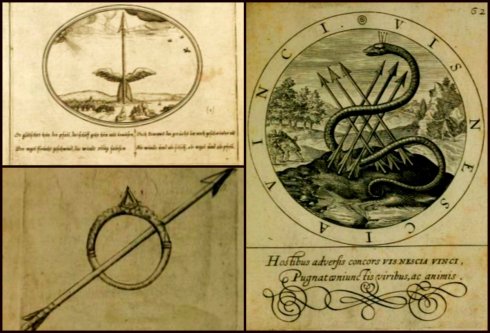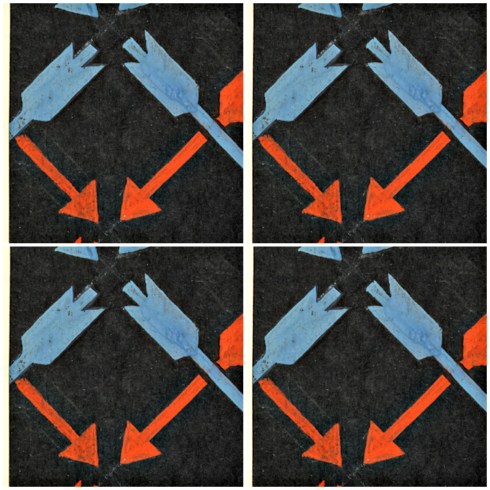Historical imagery often contains symbols and emblems that we don’t understand: we must learn to read them; whereas a contemporary audience could simply see them and understand the message within. I enjoy teasing out the meanings behind images from the past both here and in class–though here I’ve got a bit more creative freedom, and can chart the evolution of images all the way up to the present, when they have often lost their associations and exist simply as images. A great case in point (literally) is the simple and straightforward arrow: once I’ve swept away my seasonal decorations at home I’m often left with a bunch of arrows here and there as they are seasonless, timeless, and largely meaningless: I simply like their form. This is an Americana week for several auction houses, and yesterday as I was perusing the digital catalog for an important auction of folk art at Sotheby’s (The History of Now: The Important American Folk Art Collection of David Teiger|Sold to Benefit Teiger Foundation for the Support of Contemporary Art) all I could see was arrows, which for the most part had assumed their modern directional meaning on myriad weathervanes.



 Prancing Horse, Diana the Huntress, Soaring Bird, and the Goddess of Liberty weathervanes from the Teiger collection, Sotheby’s.
Prancing Horse, Diana the Huntress, Soaring Bird, and the Goddess of Liberty weathervanes from the Teiger collection, Sotheby’s.
Another lot in this same auction is an incredible later nineteenth-century Chinese wall plaque representing the Great Seal of the United States, with the emblazoned bald eagle clutching a cluster of arrows in his left talon—thirteen to be exact, representing the thirteen colonies, but also strength through unity. There is an explicit sense of martial strength on display as well, projected through the contrast with the olive branch in the eagle’s right talon. The Great Seal’s designer, Charles Thompson, was influenced in his use of arrows by other confederations such as the Iroquois (with their five nations) and the Dutch Republic (with its seven provinces) as well as by early modern emblem books such as Joachim Camerarius’s Symbola et Emblemata (1590-1604), merely substituting them for the more classical lightening bolts.


 The Chinese Great Seal and Charles Thompson’s original sketch, US National Archives; Joachim Camerarius, Symbola et Emblemata.
The Chinese Great Seal and Charles Thompson’s original sketch, US National Archives; Joachim Camerarius, Symbola et Emblemata.
Emblem books are one of the rabbit holes of early modern literature, as you will see if you go here: but you can also find many arrows, representing not only military force, but also time and inevitable mortality, flight, children (Psalm 127), punishment, and of course love, when in one of the countless cupids’ bows. Medieval arrows are never ambiguous: they represent force and violent death in general, and martyrdom in particular. Saint Sebastian (died 288) and King Edmund the Martyr (d. 869) were both attacked by hordes of pagan/heathen archers, and so often depicted as shot so full of arrows they resemble porcupines; arrows remained their essential attributes as their cults developed over the medieval era. In the later medieval era, Sebastian re-emerged as the most popular plague saint, as the arrow came to symbolize the plague itself: the most dramatic expression of this motif is a fourteenth-century fresco on the wall of the former Benedictine Abbey of Saint-André-de-Lavauadieu in France, depicting a faceless woman armed with the arrows of plague and her pierced victims all around her.




Some early modern arrow emblems: “Ich fliehe sehr schnell”– Fly far and fast; “Vis nescia vinci”–force cannot be overcome with force; “Supplicio laus tuta semel”—he that was worthy of praise was one free from punishment; Cupid holds up the world: “Sublato Amore Omnia Ruunt“–When Love is Removed, All things tumble down; the Lavaudieu fresco, and a street sign in Bury St. Edmunds, bearing the three arrow-crossed crowns that have come to symbolize the Anglo-Saxon king Edmund the Martyr.
Back to the future: I guess arrows are just arrows, or mundane symbols telling us where to go, BUT who knew there was a hidden arrow in the FedEx logo? Not me.


Mid-century textile design by Tommi Parzinger, Cooper-Hewitt Museum.






January 19th, 2019 at 8:50 am
Donna
Loved this one….Thank you
also I first noticed the FEDEX arrow about 20 years ago
and have been asking friends to look for it
Lou
January 19th, 2019 at 9:44 am
Boy I never did!
February 1st, 2019 at 2:10 pm
The Great Seal of the United States was once cut with an improper number of arrows; see referent to 1841 die: https://en.wikipedia.org/wiki/Great_Seal_of_the_United_States